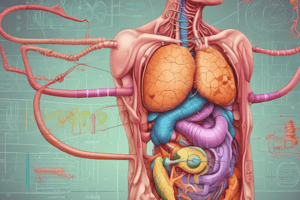Podcast
Questions and Answers
What is the primary term used to describe the food that has been mixed with gastric juice in the stomach?
What is the primary term used to describe the food that has been mixed with gastric juice in the stomach?
- Feces
- Chyme (correct)
- Bolus
- Digesta
What enzyme begins the digestion of triglycerides within the stomach?
What enzyme begins the digestion of triglycerides within the stomach?
- Lingual lipase (correct)
- Salivary amylase
- Pepsin
- Gastric lipase
Which type of cell in the stomach secretes pepsinogen?
Which type of cell in the stomach secretes pepsinogen?
- Mucous cells
- Enteroendocrine cells
- Chief cells (correct)
- Parietal cells
What is the function of hydrochloric acid (HCl) in the stomach?
What is the function of hydrochloric acid (HCl) in the stomach?
What condition is necessary for pepsin to function effectively in the stomach?
What condition is necessary for pepsin to function effectively in the stomach?
What is the role of carbonic anhydrase in the parietal cells of the stomach?
What is the role of carbonic anhydrase in the parietal cells of the stomach?
What results from the action of the H+/K+ pump in parietal cells?
What results from the action of the H+/K+ pump in parietal cells?
Why does gastric lipase have a diminished role in fat digestion compared to pancreatic lipase?
Why does gastric lipase have a diminished role in fat digestion compared to pancreatic lipase?
What effect does acidic stomach secretion have on salivary amylase?
What effect does acidic stomach secretion have on salivary amylase?
What is a consequence of the bicarbonate ion that leaves the parietal cells?
What is a consequence of the bicarbonate ion that leaves the parietal cells?
Flashcards
Stomach Mixing
Stomach Mixing
The stomach uses mixing waves instead of peristalsis to mix food with gastric juice.
Chyme
Chyme
The liquid form of food in the stomach after mixing with juices.
Gastric Juice
Gastric Juice
The liquid in the stomach containing enzymes and acids crucial for digestion.
HCl Activation of Lipases
HCl Activation of Lipases
Signup and view all the flashcards
Parietal Cell Function
Parietal Cell Function
Signup and view all the flashcards
Bicarbonate Ions
Bicarbonate Ions
Signup and view all the flashcards
Pepsinogen
Pepsinogen
Signup and view all the flashcards
Pepsin Activation
Pepsin Activation
Signup and view all the flashcards
Gastric Lipase
Gastric Lipase
Signup and view all the flashcards
Protein Digestion in Stomach
Protein Digestion in Stomach
Signup and view all the flashcards
Study Notes
Stomach Mixing and Digestion
- Stomach uses mixing waves (not peristaltic) to mix food with gastric juice.
- This mixing creates chyme, the liquidized food in the stomach.
- Gastric juice dissolves food, making it more liquid.
Stomach Acid and Enzyme Activity
- Acidic stomach secretions inactivate salivary amylase.
- Stomach acid activates lingual lipase. Lingual lipase starts breaking down triglycerides.
Proton Pump Function
- The proton pump is actually an H+/K+ pump.
- The pump uses ATP for energy.
- This pump moves potassium ions into parietal cells and hydrogen ions into the stomach lumen.
- Chloride and potassium ions diffuse into the stomach lumen.
Hydrochloric Acid Production
- Carbonic anhydrase catalyzes CO2 and water into carbonic acid (H2CO3).
- Carbonic acid dissociates into bicarbonate and hydrogen ions (HCO3- and H+).
- Bicarbonate ions leave the parietal cell, creating an "alkaline tide" in the bloodstream.
- Hydrogen ions are actively pumped into the stomach lumen by the H+/K+ pump.
- Hydrochloric acid (HCl) eliminates microorganisms, denatures proteins, and stimulates bile and pancreatic juice secretion.
Protein Digestion in the Stomach
- Stomach produces pepsin, an enzyme secreted by chief cells.
- Pepsin requires a low pH for optimal activity.
- Pepsin is released as pepsinogen (inactive form).
- An activation process takes place either by HCl or activated pepsin to prevent protein autodigestion.
Lipids Digestion in the Stomach
- The stomach also produces gastric lipase for lipid digestion.
- Gastric lipase optimal pH is 5-6.
- Pancreatic lipase becomes the most significant lipid-breaking enzyme in the digestive tract due to the maintained pH in the small intestine.
Studying That Suits You
Use AI to generate personalized quizzes and flashcards to suit your learning preferences.




